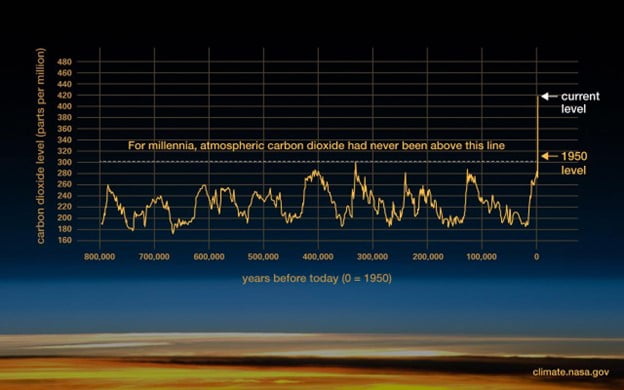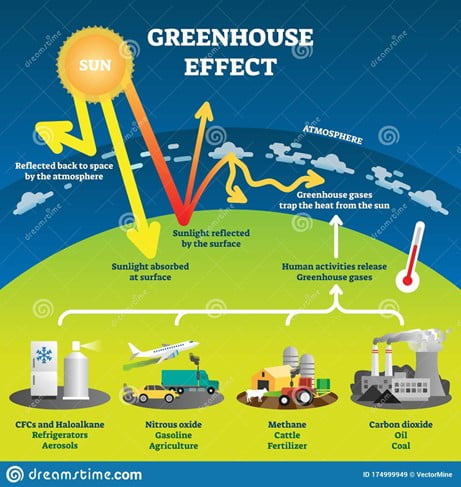Climate change and viable ways to reduce it

Climate change is the set of all those changes in temperatures and weather patterns that our planet experiences. The Earth has always had changes in its weather conditions for millions of years over the past. Some examples of these changes are ‘The Maunder Minimum’: A period in which solar energy dropped from 0.04% to 0.08%. Scientists said this might have caused a ‘little ice age’ from the 15th to the 18th century. Volcanic eruptions also influence changes in the atmosphere. It is the case of the Ilopango volcano in El Salvador around the year 539 to 540 A.D. Sulfuric acid remained in the atmosphere for years screening the sunlight, bringing cold summers, famine, and plague all around the world.
Lee: Reading: a door to success
So, as we can see, the Earth has been dealing with many changes in its weather. It is a normal cycle of our planet. However, since the 1800s human activities have been the principal driver of climate change, especially the burning of fossil fuels like coal, oil, and gas.

What is causing abnormal climate change nowadays?
Other than what we mentioned earlier (burning fossil fuels like coal, oil, and gas) there are other reasons why climate change is unnaturally accelerating: deforestation, uncontrolled agriculture, and cement, among others. These activities heat up the Earth for a process known as the greenhouse effect.
Burning fossil fuels
When we burn these to make energy or everyday objects, we release the stored carbon dioxide into the air which is a gas that stays in the atmosphere and, in a process called the greenhouse effect, heats up the Earth.
Deforestation
Forests store carbon dioxide from the atmosphere. Cutting trees and forests down means that this CO2 will not be stored, but remain outside. On top of that, when trees are burned, they release all the carbon they kept.
Agriculture
We know very well that we need this activity to survive as humanity. However, the animals we rear in this practice produce methane, which is 30 times more powerful than CO2 as a greenhouse gas. Regarding crops, the nitrous oxide used for fertilizers is nearly 300 times more severe than carbon dioxide!
Cement
Producing cement is another contributor to climate change, causing 2% of our entire carbon dioxide emissions.
Conoce: English for life by CAC Eurocentres

What are we doing to stop this?
The greenhouse effect is actually necessary to keep the earth at a livable temperature. If it were not for this process, we would freeze and life would not be possible. The problem is that human activities are unnaturally accelerating the process of heating at a rate that living creatures and ecosystems can’t adapt. That is to say, if we don’t control this, there will be a catastrophe for humanity, according to science.
For this, the Paris Agreement of 2015 was settled among 193 parties plus the European Union. This agreement has 3 main long—term goals:
- Reduce the global rising temperature of this century to 2 degrees Celsius, up to 1.5°C
- Review countries’ commitments every five years
- Provide financing to developing countries to mitigate climate change, which are the most affected.
Conoce: English for life by CAC Eurocentres
Evidence of the effect of rising temperatures and greenhouse gases effects
Millions of people are already suffering the effects of extreme weather disasters worsened by climate change. They go from longer droughts in sub-Saharan Africa to devastating tropical storms in the Caribbean and Southeast Asia. Extremely hot temperatures have caused deadly heatwaves in Europe and wildfires in Australia, South Korea, Croatia, and Algeria. This year (2022) The UK reached unprecedented temperatures of 40 °C that killed over a thousand people. There were severe floods in Pakistan that left thousands of homeless people and over 1500 deaths.
In my country, Colombia, I remember that on the beaches of Bocagrande, in the city of Cartagena, there used to be shellfish on the sand. That was about 15 years ago when I was a kid. Nowadays, you do not find any of that. Besides, in the Rosario Islands near Barú, there used to be way more marine life. I returned there 2 years ago, and I found about 40% of the initial species and plants. It’s like the ecosystems were slowly dying in a matter of a few decades. Moreover, many of the Colombian mounts that have glaciers have disappeared, and those that remain are at a high risk of fading, too.
The cities of Bogotá and Medellín aren’t as cold as they used to be in the past, I’m talking about 20 years ago. Those are some pieces of evidence of how climate change has affected some Colombian cities. Fortunately, we have not been as unlucky as countries like Pakistan or Bangladesh, where the cost of climate change-related disasters between the years 2000 and 2019 was 3.72 billion dollars.
Conoce: English training for business
Viable ways to help the climate change cause
Invest in renewable energy
Changing our main energy sources to clean and renewable is the best way to stop using fossil fuels.
Switch to sustainable transport
Try to reduce car use, switch to electric vehicles and minimize plane travel. It will reduce air pollution.
Improve farming and encourage vegan diets
A big change would be for consumers to reduce their meat and dairy consumption. Businesses and food retailers can improve farming practices and provide more plant-based products to help people make the shift.
Protect forests and restore nature to absorb more carbon dioxide
We need to look after the world’s lungs and also increase them as we have increased our carbon activities.
Reduce plastic
Making plastic is carbon-intense. It doesn’t break down easily, so a lot of it is burned, which contributes to emissions.
It’s easy to feel overwhelmed, and to feel that climate change is too big to solve. But we already have the answers, now it’s a question of making them happen. To work, all of these solutions need strong international cooperation between governments and businesses, including the most polluting sectors.
Individuals can also play a part by making better choices about where they get their energy, how they travel, and what food they eat. But the best way for anyone to help stop climate change is to take collective action. This means pressuring governments and corporations to change their policies and business practices.
Governments want to be re-elected. And businesses can’t survive without customers. Demanding action from them is a powerful way to make change happen.
References
Concern worldwide. (2022) 10 of the countries most affected by climate change
United Nations. (2015) The Paris Agreement https://www.un.org/en/climatechange/paris-agreement
United Nations. (2010) What is climate change? https://www.un.org/en/climatechange/what-is-climate-change
Amnesty International. (2022) Climate Change https://www.amnesty.org/en/what-we-do/climate-change/?utm_source=google&utm_medium=cpc&gclid=CjwKCAjw-rOaBhA9EiwAUkLV4mkR1qJkf-hyezAkgl3yArESvnAWNLqGxJ4i0pmds2PszdnONVPEXBoCEHQQAvD_BwE
NRDC. (2022) How you can stop global warming https://www.nrdc.org/stories/how-you-can-stop-global-warming
Green Peace. (n.d) What are the solutions to climate change? https://www.greenpeace.org.uk/challenges/climate-change/solutions-climate-change/
Luis Cásseres
Tag:Vocabulary, writing



